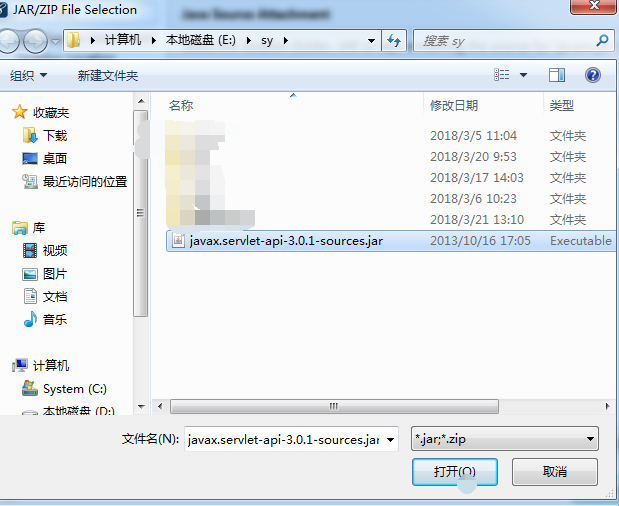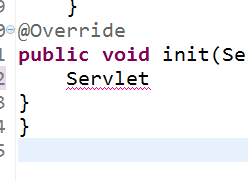1,下载源码,点击此处可下载
2,创建web项目

我这里以jdbc这个web项目为例讲解

在javaee libraries中有个javaee.jar包,选中它-->右击--》Properties

找到你下载的jar包

打开---apply 即可】
在任意一个.java文件中,编写servlet,按住ctrl键,鼠标单击类(或接口)名,即可查看源码

下面是servlet完整源码
/* * DO NOT ALTER OR REMOVE COPYRIGHT NOTICES OR THIS HEADER. * * Copyright (c) 1997-2010 Oracle and/or its affiliates. All rights reserved. * * The contents of this file are subject to the terms of either the GNU * General Public License Version 2 only ("GPL") or the Common Development * and Distribution License("CDDL") (collectively, the "License"). You * may not use this file except in compliance with the License. You can * obtain a copy of the License at * https://glassfish.dev.java.net/public/CDDL+GPL_1_1.html * or packager/legal/LICENSE.txt. See the License for the specific * language governing permissions and limitations under the License. * * When distributing the software, include this License Header Notice in each * file and include the License file at packager/legal/LICENSE.txt. * * GPL Classpath Exception: * Oracle designates this particular file as subject to the "Classpath" * exception as provided by Oracle in the GPL Version 2 section of the License * file that accompanied this code. * * Modifications: * If applicable, add the following below the License Header, with the fields * enclosed by brackets [] replaced by your own identifying information: * "Portions Copyright [year] [name of copyright owner]" * * Contributor(s): * If you wish your version of this file to be governed by only the CDDL or * only the GPL Version 2, indicate your decision by adding "[Contributor] * elects to include this software in this distribution under the [CDDL or GPL * Version 2] license." If you don't indicate a single choice of license, a * recipient has the option to distribute your version of this file under * either the CDDL, the GPL Version 2 or to extend the choice of license to * its licensees as provided above. However, if you add GPL Version 2 code * and therefore, elected the GPL Version 2 license, then the option applies * only if the new code is made subject to such option by the copyright * holder. * * * This file incorporates work covered by the following copyright and * permission notice: * * Copyright 2004 The Apache Software Foundation * * Licensed under the Apache License, Version 2.0 (the "License"); * you may not use this file except in compliance with the License. * You may obtain a copy of the License at * * http://www.apache.org/licenses/LICENSE-2.0 * * Unless required by applicable law or agreed to in writing, software * distributed under the License is distributed on an "AS IS" BASIS, * WITHOUT WARRANTIES OR CONDITIONS OF ANY KIND, either express or implied. * See the License for the specific language governing permissions and * limitations under the License. */ package javax.servlet; import java.io.IOException; /** * Defines methods that all servlets must implement. * * <p>A servlet is a small Java program that runs within a Web server. * Servlets receive and respond to requests from Web clients, * usually across HTTP, the HyperText Transfer Protocol. * * <p>To implement this interface, you can write a generic servlet * that extends * <code>javax.servlet.GenericServlet</code> or an HTTP servlet that * extends <code>javax.servlet.http.HttpServlet</code>. * * <p>This interface defines methods to initialize a servlet, * to service requests, and to remove a servlet from the server. * These are known as life-cycle methods and are called in the * following sequence: * <ol> * <li>The servlet is constructed, then initialized with the <code>init</code> method. * <li>Any calls from clients to the <code>service</code> method are handled. * <li>The servlet is taken out of service, then destroyed with the * <code>destroy</code> method, then garbage collected and finalized. * </ol> * * <p>In addition to the life-cycle methods, this interface * provides the <code>getServletConfig</code> method, which the servlet * can use to get any startup information, and the <code>getServletInfo</code> * method, which allows the servlet to return basic information about itself, * such as author, version, and copyright. * * @author Various * * @see GenericServlet * @see javax.servlet.http.HttpServlet * */ public interface Servlet { /** * Called by the servlet container to indicate to a servlet that the * servlet is being placed into service. * * <p>The servlet container calls the <code>init</code> * method exactly once after instantiating the servlet. * The <code>init</code> method must complete successfully * before the servlet can receive any requests. * * <p>The servlet container cannot place the servlet into service * if the <code>init</code> method * <ol> * <li>Throws a <code>ServletException</code> * <li>Does not return within a time period defined by the Web server * </ol> * * * @param config a <code>ServletConfig</code> object * containing the servlet's * configuration and initialization parameters * * @exception ServletException if an exception has occurred that * interferes with the servlet's normal * operation * * @see UnavailableException * @see #getServletConfig * */ public void init(ServletConfig config) throws ServletException; /** * * Returns a {@link ServletConfig} object, which contains * initialization and startup parameters for this servlet. * The <code>ServletConfig</code> object returned is the one * passed to the <code>init</code> method. * * <p>Implementations of this interface are responsible for storing the * <code>ServletConfig</code> object so that this * method can return it. The {@link GenericServlet} * class, which implements this interface, already does this. * * @return the <code>ServletConfig</code> object * that initializes this servlet * * @see #init * */ public ServletConfig getServletConfig(); /** * Called by the servlet container to allow the servlet to respond to * a request. * * <p>This method is only called after the servlet's <code>init()</code> * method has completed successfully. * * <p> The status code of the response always should be set for a servlet * that throws or sends an error. * * * <p>Servlets typically run inside multithreaded servlet containers * that can handle multiple requests concurrently. Developers must * be aware to synchronize access to any shared resources such as files, * network connections, and as well as the servlet's class and instance * variables. * More information on multithreaded programming in Java is available in * <a href="http://java.sun.com/Series/Tutorial/java/threads/multithreaded.html"> * the Java tutorial on multi-threaded programming</a>. * * * @param req the <code>ServletRequest</code> object that contains * the client's request * * @param res the <code>ServletResponse</code> object that contains * the servlet's response * * @exception ServletException if an exception occurs that interferes * with the servlet's normal operation * * @exception IOException if an input or output exception occurs * */ public void service(ServletRequest req, ServletResponse res) throws ServletException, IOException; /** * Returns information about the servlet, such * as author, version, and copyright. * * <p>The string that this method returns should * be plain text and not markup of any kind (such as HTML, XML, * etc.). * * @return a <code>String</code> containing servlet information * */ public String getServletInfo(); /** * * Called by the servlet container to indicate to a servlet that the * servlet is being taken out of service. This method is * only called once all threads within the servlet's * <code>service</code> method have exited or after a timeout * period has passed. After the servlet container calls this * method, it will not call the <code>service</code> method again * on this servlet. * * <p>This method gives the servlet an opportunity * to clean up any resources that are being held (for example, memory, * file handles, threads) and make sure that any persistent state is * synchronized with the servlet's current state in memory. * */ public void destroy(); }